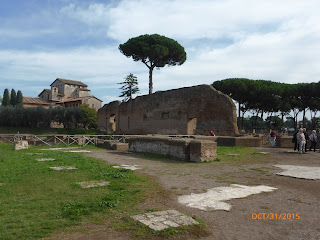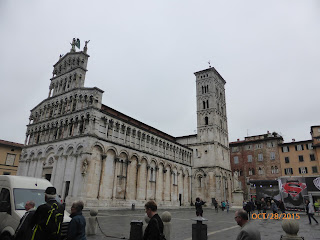We cabbed it down the hill from the hotel early on Halloween morning to meet our guide at the Oppio Cafe. The cabbie dropped us off in front of the cafe and we were early enough to go inside and get a cappuccino and a bite of breakfast. This cafe is a good meeting point to start a visit of the Colosseum and the many other Roman ruins that are nearby. The meeting point was basically right above the Via dei Fori Imperiali, a road that the dictator Benito Mussolini built between 1924-32. This road connects many of the attractions in the area and is really all that separates the Colosseum from the Oppio Cafe .
At precisely the appointed time of 8:30 AM, our guide Elisabeth from Context Travel showed up. We were lucky because although Context groups normally have the maximum of 6 people per guide, we had Elisabeth to ourselves. We started with a quick history lesson before crossing the Via dei Fori Imperiali and entering the Colosseum. It turned out to be very important to review the succession of the Roman emperors from the time of Christ to about 200 AD. The various historic sites we would visit were built at different times by different emperors, so being able to put it all into context was important. Elisabeth is a well-educated Archeologist and prior to guiding and teaching she was involved in many archeological digs. So, she was the right one to show us around. She carried a laminated textbook with her which she referred to many times during our tour and it was helpful to set the stage for many discussions that morning.
The Colosseum was amazing. The building itself was built between 72 AD and 80 AD. It was started under Vespasian's reign and finished under his son Titus' reign. It was financed by the sacking of Jerusalem during the Jewish Rebelian of 66-73 AD. Both Vespasian and his son Titus led Roman armies during that war and returned to Rome with the spoils of war and numerous Jewish slaves to help build the structure. There is a pretty good museum located on the upper floor just inside the outer wall that displays some of the artifacts found at the site and gives the visitor an impression of how the building was used by the Romans. We didn't have enough time there to really see all the exhibits.
Right outside the Colosseum, our next stop was the Arch of Constantine. It was completed in 315 AD and commemorates Constantine's victory in the battle of Milvian Bridge in 312 AD. Elisabeth explained that the arch contained a lot of reliefs from earlier works dedicated to earlier emperors and was then a kind of collage of styles pasted together. I guess the artists had to improvise when the imperial grants ran out.
We would then scale Palatine Hill to visit the ruins of the Flavian Palace. At this point, I would like to tell you that we hiked a long distance over uneven ground on that day. We also climbed a record number of stairs as measured by my iPhone. It was a good workout, trapsing around Ancient Rome and the Vatican, so I am glad I did it when I was relatively young.
Palatine Hill was pretty cool. There is basically a big outdoor museum on the hill that archeologists agree is the site of the first human habitation of the area during the Bronze Age. Before the Roman Emperors established the hill as the site of their palaces, all of the affluent romans built their cribs up there, as it was the neighborhood of choice for the rich and famous. Augustus, his successor Tiberius and later on the Flavian Emperors (Vespasian and his sons Titus and Domitian) would boot out all the merely rich people, expropriating their land to build increasing larger and more elaborate hang-outs for themselves. We spent a lot of time looking at the work of Domitian on a Palace that had been started by his brother Titus and his father Vespasian that both ruled before him. On the brow of the hill this palace had the best seats for the chariot races, as they looked directly down over Circus Maximus from the southern side of heir palace. Mrs. Gym and I looked down on that same view that Domitian had viewed the races and unfortunately, today there is nothing left of the stadium that once sat 250,000 people. The bowl is still there and you see how big it was but it ain't as grand as it was when Ben Hur raced around down there.
The last part of our tour with Elisabeth took us down off Palatine Hill and into the famous Roman Forum, the centre of the ancient city. We stood next to the Temple of Vesta where the Vestal Virgins tended the Sacred Fire of Vesta, a flame that had to be kept burning so that the fortunes of the city would continue to be positive. All around the Forum, are important civic buildings in various states of repair. Here, senators gave speeches, processions and parades passed through, trials were conducted and most of the commercial activity took place. My feet were getting tired on these old Roman roads and I have tell you that you have to pick your feet up when strolling about around the Forum. I bet there has been some nasty spills on those uneven surfaces as people are looking at ruins and not being mindful of their footing.
We finished our 4-hour Roma Antica Tour exiting the forum area not far from Trajan's Market, near Piazza Venezia where there was a taxi stand. We said goodbye to Elisabeth there where Mussolini's Via die Fori Imperiale connects to the piazza. We had to rush to meet out Vatican tour guide.
 |
| The Colosseum in the early morning from the Oppio Cafe |
 |
| These are the stairs up the the top levels of the colosseum where the poor people and the women of any class had to sit. Only wealthy or powerful men could sit in the lower levels. |
 |
| This is a display in the museum that is inside the colosseum. These are counterweights used to raise up the cast of a performance from beneath the floor of the arena. |
 |
| Here you can see where they have restored a portion of the arena floor |
 |
| this view looks down at the floor and shows the sub-floor corridors where the gladiators and wild animals waited for their cue to be raised up through the floor when their events began. |
 |
| The Arch of Constantine commemorating victory at the Battle of Milvian Bridge in 312 AD |
 |
| Side view of the Arch which spans Via triumphalis, the road of victorious emperors entered the city |
 |
| The top of Palantine Hill |
 |
| Looking down two levels to a water feature on the main floor. |
 |
| The Hippodrome of Domitian is next to the Flavian Palace ruins. It is a private green space for Domitian where he may have been entertained in a private setting. It is big, about 150 meters long. |
 |
| A typical roman road - watch your step! |
 |
| The Temple of Vesta. |
 |
| Buildings surviving today around the Roman Forum include the Senate. |














































